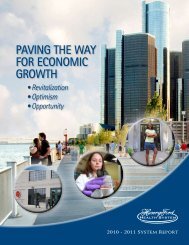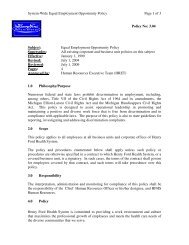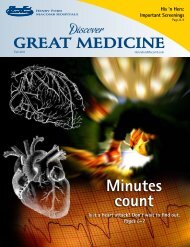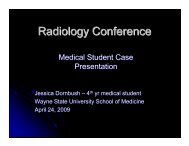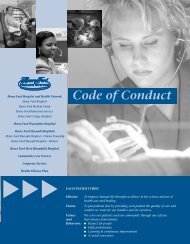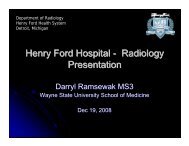Create successful ePaper yourself
Turn your PDF publications into a flip-book with our unique Google optimized e-Paper software.
<strong>Tricuspid</strong> <strong>Atresia</strong><br />
Andrew Bunney MS3<br />
WSUSOM<br />
2/20/09
History<br />
• 25 year old African American female with chest<br />
pain and history of multiple cardiac surgeries.<br />
Rule out pulmonary embolism.
Images
Images
Images
Images
Images
Findings<br />
• Bibasilar pleural effusions with associated atelectasis. . No<br />
evidence of pulmonary embolism.<br />
• Pulmonary artery exits heart from right atrium<br />
• Hypoplastic right ventricle with dystrophic calcification or<br />
surgical material.<br />
• Markedly enlarged coronary sinus<br />
• Markedly enlarged inferior vena cava<br />
• Right subclavian artery has a graft connecting it to the<br />
pulmonary artery, but is currently occluded and calcified. Ductus<br />
arteriosus present and also occluded and calcified.<br />
• Dilated hepatic vessels with hepatomegaly. . Enhancing<br />
subcapsular lesions in upper liver.
Differential Diagnosis<br />
• Pleural effusion secondary to congestive heart<br />
failure.<br />
• Pulmonary Embolism secondary to<br />
thromboembolic disease<br />
• Myocardial infarction secondary to cardiomegaly<br />
• Atrial fibrillation secondary to markedly dilated<br />
right atrium.
Diagnosis<br />
• Pulmonary embolism is ruled out. Pleural<br />
effusion can cause chest pain, but no definitive<br />
radiological evidence can explain the presenting<br />
symptom.
Discussion<br />
• <strong>Tricuspid</strong> atresia is a congenital anomaly defined by the complete agenesis of<br />
the tricuspid valve.<br />
• Atrial-septal<br />
defects<br />
• Ventricular-septal<br />
defects<br />
• Ductus Arteriosus<br />
• Without surgical intervention, mortality is 90% by age 10. With surgery<br />
patients can live into 3 rd and 4 th decade of life.<br />
• Classified by relationship with great arteries<br />
• Type I: normally related great arteries<br />
• Type II: D-transposition D<br />
of great arteries<br />
• Type III: L-transposition L<br />
of great arteries<br />
• Subtype A: pulmonary atresia<br />
• Subtype B: pulmonic stenosis<br />
• Subtype C: no pulmonary obstruction<br />
• Type Ib is most common: <strong>Tricuspid</strong> atresia with normally related great arteries, a<br />
small ventricular defect, and pulmonic stenosis.
Fontan Procedure<br />
• Keep ductus arteriosus patent<br />
• Need low pulmonary vascular resistance, cannot do surgery<br />
in neonates.<br />
• Blalock-Taussig<br />
shunt<br />
• Classic Fontan procedure has two parts<br />
• 1 st<br />
• 2 nd<br />
st procedure:<br />
• Bidirectional Glenn – end-to<br />
to-end<br />
anastamosis between cranial SVC<br />
and Right pulmonary artery, cardiac SVC ligated.<br />
• Hemi-Fontan<br />
– Cranial and cardiac SVC anastamosed to right<br />
pulmonary artery<br />
nd procedure: Anastomosis of left pulmonary artery to RA,<br />
valved homografts at IVC-RA and RA-LPA.
Modifications to the Fontan<br />
Procedure<br />
• Two currently being used<br />
• Lateral Tunnel Fontan procedure<br />
• Extracardiac Conduit<br />
• Atriopulmonary Connection<br />
• Main pulmonary artery directly connected to RA<br />
without any valved homografts.<br />
• Was in wide use until abandoned due to<br />
development of severe RA dilatation leading to<br />
recurrent atrial arrhythmias and subsequent<br />
thromboembolic disease.
References<br />
• Strife, Janet. <strong>Tricuspid</strong> <strong>Atresia</strong>. Statdx; ; Sep. 01,<br />
2006.<br />
• Ramaswamy, Prema. <strong>Tricuspid</strong> <strong>Atresia</strong> and Fontan<br />
Procedure. eMedicine; ; Nov. 24, 2008.<br />
• Novelline, , Robert. Squire’s s Fundamentals of<br />
Radiology. Boston, MA: President and Fellows of<br />
Harvard College, 2004.






